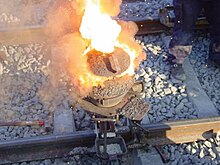
Aluminium is a chemical element; it has symbol Al and atomic number 13. Aluminium has a density lower than that of other common metals; about one-third that of steel. It has a great affinity towards oxygen, forming a protective layer of oxide on the surface when exposed to air. Aluminium visually resembles silver, both in its color and in its great ability to reflect light. It is soft, nonmagnetic and ductile. It has one stable isotope: 27Al, which is highly abundant, making aluminium the twelfth-most common element in the universe. The radioactivity of 26Al is used in radiometric dating.

Barium is a chemical element; it has symbol Ba and atomic number 56. It is the fifth element in group 2 and is a soft, silvery alkaline earth metal. Because of its high chemical reactivity, barium is never found in nature as a free element.
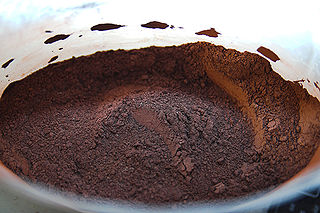
Thermite is a pyrotechnic composition of metal powder and metal oxide. When ignited by heat or chemical reaction, thermite undergoes an exothermic reduction-oxidation (redox) reaction. Most varieties are not explosive, but can create brief bursts of heat and high temperature in a small area. Its form of action is similar to that of other fuel-oxidizer mixtures, such as black powder.
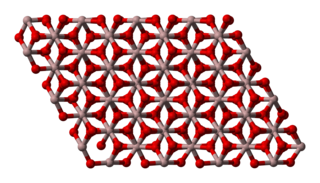
Aluminium oxide (or aluminium(III) oxide) is a chemical compound of aluminium and oxygen with the chemical formula Al2O3. It is the most commonly occurring of several aluminium oxides, and specifically identified as aluminium oxide. It is commonly called alumina and may also be called aloxide, aloxite, or alundum in various forms and applications. It occurs naturally in its crystalline polymorphic phase α-Al2O3 as the mineral corundum, varieties of which form the precious gemstones ruby and sapphire. Al2O3 is significant in its use to produce aluminium metal, as an abrasive owing to its hardness, and as a refractory material owing to its high melting point.
The Hall–Héroult process is the major industrial process for smelting aluminium. It involves dissolving aluminium oxide (alumina) in molten cryolite, and electrolyzing the molten salt bath, typically in a purpose-built cell. The Hall–Héroult process applied at industrial scale happens at 940–980 °C and produces 99.5–99.8% pure aluminium. Recycled aluminum requires no electrolysis, thus it does not end up in this process.

Iron(III) oxide or ferric oxide is the inorganic compound with the formula Fe2O3. It is one of the three main oxides of iron, the other two being iron(II) oxide (FeO), which is rare; and iron(II,III) oxide (Fe3O4), which also occurs naturally as the mineral magnetite. As the mineral known as hematite, Fe2O3 is the main source of iron for the steel industry. Fe2O3 is readily attacked by acids. Iron(III) oxide is often called rust, since rust shares several properties and has a similar composition; however, in chemistry, rust is considered an ill-defined material, described as hydrous ferric oxide.

Industrial processes are procedures involving chemical, physical, electrical, or mechanical steps to aid in the manufacturing of an item or items, usually carried out on a very large scale. Industrial processes are the key components of heavy industry.

Johannes Wilhelm "Hans" Goldschmidt was a German chemist notable as the discoverer of the Thermite reaction. He was also co-owner of the Chemische Fabrik Th. Goldschmidt, as of 1911 Th. Goldschmidt AG and its most important chemist. The reaction, also called the Goldschmidt process, is used for thermite welding, often used to join railway tracks. Thermites have also been used in metal refining, disabling munitions, and in incendiary weapons. Some thermite-like mixtures are used as pyrotechnic initiators in fireworks.
Ferroalloy refers to various alloys of iron with a high proportion of one or more other elements such as manganese (Mn), aluminium (Al), or silicon (Si). They are used in the production of steels and alloys. The alloys impart distinctive qualities to steel and cast iron or serve important functions during production and are, therefore, closely associated with the iron and steel industry, the leading consumer of ferroalloys. The leading producers of ferroalloys in 2014 were China, South Africa, India, Russia and Kazakhstan, which accounted for 84% of the world production. World production of ferroalloys was estimated as 52.8 million tonnes in 2015.

Ferrovanadium (FeV) is an alloy formed by combining iron and vanadium with a vanadium content range of 35–85%. The production of this alloy results in a grayish silver crystalline solid that can be crushed into a powder called "ferrovanadium dust". Ferrovanadium is a universal hardener, strengthener and anti-corrosive additive for steels like high-strength low-alloy steel, tool steels, as well as other ferrous-based products. It has significant advantages over both iron and vanadium individually. Ferrovanadium is used as an additive to improve the qualities of ferrous alloys. One such use is to improve corrosion resistance to alkaline reagents as well as sulfuric and hydrochloric acids. It is also used to improve the tensile strength to weight ratio of the material. One application of such steels is in the chemical processing industry for high pressure high throughput fluid handling systems dealing with industrial scale sulfuric acid production. It is also commonly used for hand tools e.g. spanners (wrenches), screwdrivers, ratchets, etc.
Nano-thermite or super-thermite is a metastable intermolecular composite (MIC) characterized by a particle size of its main constituents, a metal and a metal oxide, under 100 nanometers. This allows for high and customizable reaction rates. Nano-thermites contain an oxidizer and a reducing agent, which are intimately mixed on the nanometer scale. MICs, including nano-thermitic materials, are a type of reactive materials investigated for military use, as well as for general applications involving propellants, explosives, and pyrotechnics.

Ferrosilicon is an alloy of iron and silicon with a typical silicon content by weight of 15–90%. It contains a high proportion of iron silicides.

Exothermic welding, also known as exothermic bonding, thermite welding (TW), and thermit welding, is a welding process that employs molten metal to permanently join the conductors. The process employs an exothermic reaction of a thermite composition to heat the metal, and requires no external source of heat or current. The chemical reaction that produces the heat is an aluminothermic reaction between aluminium powder and a metal oxide.
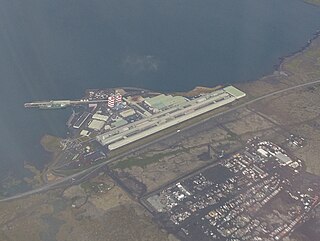
Aluminium smelting is the process of extracting aluminium from its oxide, alumina, generally by the Hall-Héroult process. Alumina is extracted from the ore bauxite by means of the Bayer process at an alumina refinery.
Ferroniobium is an important iron-niobium alloy, with a niobium content of 60-70%. It is the main source for niobium alloying of HSLA steel and covers more than 80% of the worldwide niobium production. The niobium is mined from pyrochlore deposits and is subsequently transformed into the niobium pentoxide Nb2O5. This oxide is mixed with iron oxide and aluminium and is reduced in an aluminothermic reaction to niobium and iron. The component metals can be purified in an electron beam furnace or the alloy can be used as it is. For alloying with steel the ferroniobium is added to molten steel before casting. The largest producers of ferroniobium are the same as for niobium and are located in Brazil and Canada.
Ferro molybdenum is an important iron-molybdenum metal alloy, with a molybdenum content of 60-75% It is the main source for molybdenum alloying of HSLA steel.
Deoxidized steel is steel that has some or all of the oxygen removed from the melt during the steelmaking process. Liquid steels contain dissolved oxygen after their conversion from molten iron, but the solubility of oxygen in steel decreases with cooling. As steel cools, excess oxygen can cause blowholes or precipitate FeO. Therefore, several strategies have been developed for deoxidation. This may be accomplished by adding metallic deoxidizing agents to the melt either before or after it is tapped, or by vacuum treatment, in which carbon dissolved in the steel is the deoxidizer.

Ethylaluminium sesquichloride, also called EASC, is an industrially important organoaluminium compound used primarily as a precursor to triethylaluminium and as a catalyst component in Ziegler–Natta type systems for olefin and diene polymerizations. Other applications include use in alkylation reactions and as a catalyst component in linear oligomerization and cyclization of unsaturated hydrocarbons. EASC is a colourless liquid, spontaneously combustible in air and reacts violently when in contact with water and many other compounds.
Ferroaluminum (FeAl) is a ferroalloy, consisting of iron and aluminium. The metal usually consists of 40% to 60% aluminium and applications of ferroaluminum include the deoxidation of steel, hardfacing applications, reducing agent, thermite reactions, AlNiCo magnets, and alloying additions to welding wires and fluxes. The alloy is also known for the ability to manufacture low melting point alloys and its ability to carry out aluminothermic welding. Ferroaluminum does not currently have a CAS Registry Number. The presence of iron in aluminum helps in the decrease of casting defects, improves tensile, yield, hardness, and maintains strength at high temperatures.
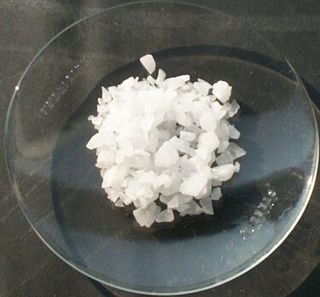
Aluminium (British and IUPAC spellings) or aluminum (North American spelling) combines characteristics of pre- and post-transition metals. Since it has few available electrons for metallic bonding, like its heavier group 13 congeners, it has the characteristic physical properties of a post-transition metal, with longer-than-expected interatomic distances. Furthermore, as Al3+ is a small and highly charged cation, it is strongly polarizing and aluminium compounds tend towards covalency; this behaviour is similar to that of beryllium (Be2+), an example of a diagonal relationship. However, unlike all other post-transition metals, the underlying core under aluminium's valence shell is that of the preceding noble gas, whereas for gallium and indium it is that of the preceding noble gas plus a filled d-subshell, and for thallium and nihonium it is that of the preceding noble gas plus filled d- and f-subshells. Hence, aluminium does not suffer the effects of incomplete shielding of valence electrons by inner electrons from the nucleus that its heavier congeners do. Aluminium's electropositive behavior, high affinity for oxygen, and highly negative standard electrode potential are all more similar to those of scandium, yttrium, lanthanum, and actinium, which have ds2 configurations of three valence electrons outside a noble gas core: aluminium is the most electropositive metal in its group. Aluminium also bears minor similarities to the metalloid boron in the same group; AlX3 compounds are valence isoelectronic to BX3 compounds (they have the same valence electronic structure), and both behave as Lewis acids and readily form adducts. Additionally, one of the main motifs of boron chemistry is regular icosahedral structures, and aluminium forms an important part of many icosahedral quasicrystal alloys, including the Al–Zn–Mg class.

